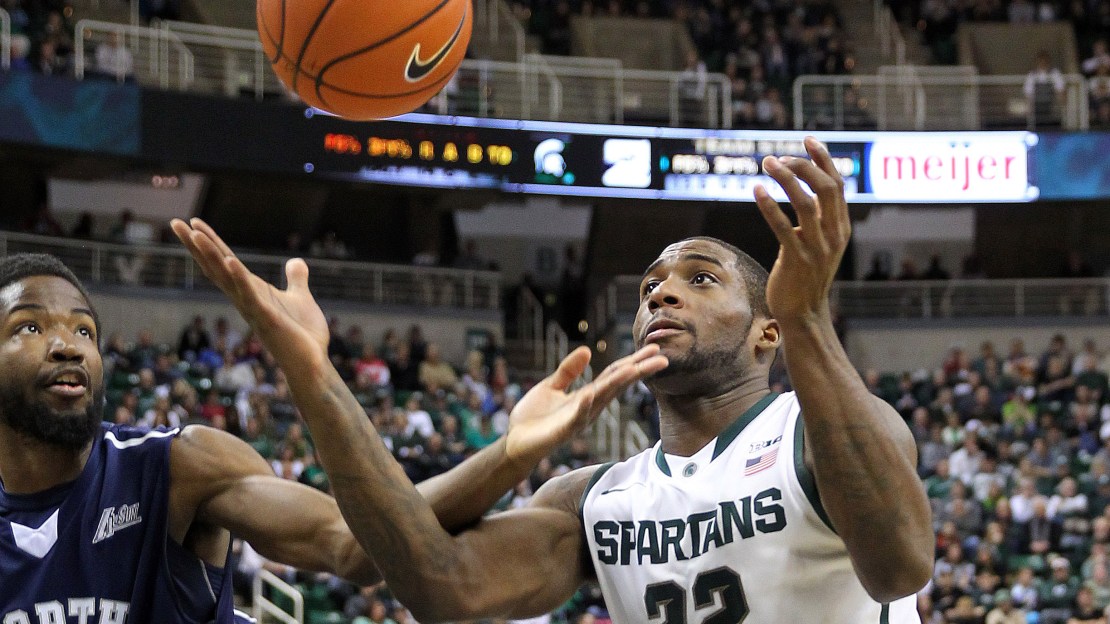BTN.com staff, December 20, 2013
It's still early, but it can be instructive to look at how Big Ten teams have performed relative to preseason expectations. With so few games of consequence being played this week, now is as good a time as any to pause and see how things have gone.
Courtesy of the ever-useful kenpom.com, here's how the rankings have evolved for Big Ten teams so far this season:
The index on the x-axis is the game number from which the ranking was taken. The first ranking is taken from before the first game (i.e. the preseason ranking), the second ranking is taken from before the second game, and so on. The lines stop a little earlier for some teams because they have yet to play their 11th or 12th game.
The first thing that jumps out is the separation between the top eight teams and the bottom four teams. That separation looks even greater if we set aside Illinois, as that stray orange line is the only thing occupying that wide swath of open space. The Big Ten has seven teams currently in the KenPom top 40, and those seven teams represent the conference's best bets for NCAA tournament bids. Those top seven teams have consistently stayed inside the national top 40, save for brief departures by Minnesota and Indiana. Being a top-40 KenPom team guarantees nothing (just ask the 2012-13 Iowa Hawkeyes), but a squad of top-40 quality generally has a good chance to make the tournament.
Illinois briefly looked like a member of the top 40 based on its tough defense, but the Illini have since reverted back to around their preseason rank. This is a team whose season could go either way – Illinois could very well improve just a little and sneak into the tournament, or a bundle of close losses could turn this into a ugly year (see 2007-08 Illinois).
As far as departures from preseason rank go, Purdue takes the cake. The Boilermakers entered the season ranked 30th and were presumed a safe bet to make the NCAA tournament. After a season opening one-point win over lowly Northern Kentucky (a team that is now 3-7 with two overtime victories), Purdue's ranking plummeted, but there was still much farther to fall.
The Boilermakers have righted the ship a bit in recent weeks, but equilibrium has seemingly been reached in the mid-80s. That level of play will not get Purdue close to the tournament, but the good news is that most of the potential resume damage has been averted. Purdue has dodged bullets thanks to a 4-0 record in games decided by five points or less. Matt Painter's team could have ended up with some horrific losses on its resume, but it didn't, so improved play could still find the Boilermakers on the right side of the bubble come March.
It's interesting to look at the bottom of the chart, where Ohio State and Michigan State began the season as the conference's only top 10 teams. The two teams have gone in opposite directions, as the Buckeyes have climbed to a consistent #2 ranking and the Spartans have slumped to the mid-teens.
At the same time, Wisconsin's stellar play against a tough schedule has propelled the Badgers' into the top 10, and even Iowa is now ahead of Michigan State. I said before the season that the Big Ten had a lot of good teams, but only one great team in Michigan State. That is looking completely wrong, as the conference race appears much more wide open than I ever expected.
As far as upside surprises, the biggest difference between preseason rank and current rank belongs to Nebraska. The Huskers were projected to be the Big Ten's only non-top-100 team, but Tim Miles' squad has played better than that. It's not a given that Nebraska will eclipse or even match last season's five conference wins, but progress is being made in Lincoln. With only senior Ray Gallegos projected to be gone, the 2014-15 season could even mark the Huskers' return to NCAA tournament contention.
If it feels like the past couple weeks have not been kind to the Big Ten, you're on to something.
The Big Ten is still the nation's top conference by a wide margin, but the past couple weeks have taken off some of the sheen. Much of that drastic spike can be attributed to Purdue's brief dalliance outside of the top 100 and rough patches for Michigan State, Illinois, and Minnesota. The conference's average ranking has recovered a bit since then and is still rather strong in a national sense.
Finally, we've reached the weekend, and with it the return of meaningful basketball games. Ohio State, Michigan, Michigan State, Illinois, and Purdue all face teams that could end up being in the top 50, so we should learn just a little more about this conference before Christmas.







